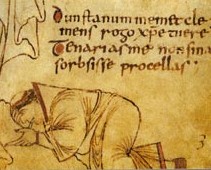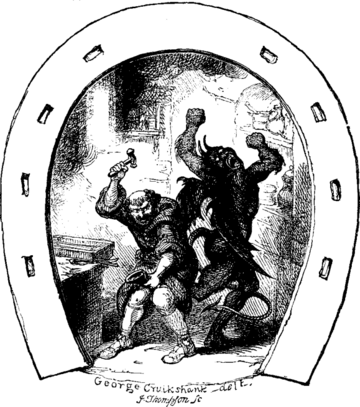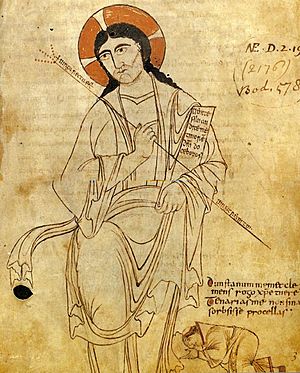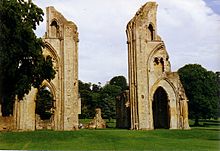Dunstan facts for kids
Quick facts for kids Dunstan |
|
|---|---|
| Archbishop of Canterbury | |

Possible self-portrait of Dunstan. Detail from the Glastonbury Classbook.
|
|
| Enthroned | 959 |
| Reign ended | 988 |
| Predecessor | Byrhthelm |
| Successor | Æthelgar |
| Personal details | |
| Born | c. 909 Baltonsborough, Wessex |
| Died | 19 May 988 (aged about 79) Canterbury, England |
| Buried | Canterbury Cathedral |
| Sainthood | |
| Feast day | 19 May |
| Venerated in | Roman Catholic Church Eastern Orthodox Church Anglican Communion |
| Canonized | 1029 |
| Attributes | man holding a pair of smith's tongs; with a dove hovering near him; with a troop of angels before him |
| Patronage | blacksmiths; Charlottetown, Canada; goldsmiths; locksmiths; musicians; silversmiths; bellringers |
| Shrines | Canterbury Cathedral (but also claimed by Glastonbury Abbey), both destroyed |
Saint Dunstan (born around 909 – died 19 May 988) was an important English bishop. He held many important roles, including Abbot of Glastonbury Abbey, Bishop of Worcester, Bishop of London, and finally Archbishop of Canterbury. Later, he became known as a saint.
Dunstan helped bring back monastic life in England. He also made many important changes to the English Church. People in the 11th century said he was very good at art and writing. He was also a key advisor to several English kings. For almost 200 years, Dunstan was one of England's most popular saints. People loved the stories about his cleverness, especially how he outsmarted the Devil.
Contents
Dunstan's Early Life (909–943)
Birth and Family Connections
Dunstan's parents were Heorstan and Cynethryth. They lived near Glastonbury. He was likely born around 910. Dunstan was related to important church leaders. These included Ælfheah the Bald, who was the Bishop of Winchester. He was also related to Cynesige, Bishop of Lichfield.
From School to the King's Court
As a young boy, Dunstan studied with Irish monks. These monks lived in the old Glastonbury Abbey. Dunstan was very hopeful and dreamed of restoring the abbey. He once had a serious illness but made a surprising recovery. Even as a child, he loved learning and was skilled in many crafts.
His parents allowed him to become a cleric. He served in the old church of St Mary. Dunstan became known for his learning. He was called to serve Athelm, who was the Archbishop of Canterbury. Later, he joined the court of King Athelstan.
Dunstan quickly became a favorite of the king. But this made other people at court jealous. They made up stories that Dunstan was involved with witchcraft. The king then told him to leave the court. As Dunstan was leaving, his enemies attacked him. They beat him and threw him into a dirty pit. He managed to get out and found a friend's house. From there, he went to Winchester. He then served Ælfheah, the Bishop of Winchester.
The bishop wanted Dunstan to become a monk. But Dunstan was not sure if he wanted to live a celibate life. Then, he got very sick with swelling all over his body. This illness was probably from the attack. It made Dunstan change his mind. In 943, he became a priest with Bishop Ælfheah.
Dunstan then returned to Glastonbury. He lived as a hermit in a small cell. It was only about 5 feet long and 2.5 feet deep. There, he studied, worked on his art, and played his harp. A famous story says that the Devil tried to tempt Dunstan there. But Dunstan grabbed the Devil's face with his tongs!
Monk and Abbot (943–957)
Life as a Monk
While at Glastonbury, Dunstan worked as a silversmith. He also worked in the scriptorium, a place where books were copied. Many believe he drew the famous picture of Christ with a small monk kneeling beside him. This drawing is in the Glastonbury Classbook. It was one of the first of its kind in Anglo-Saxon art.
Dunstan became famous as a musician, artist, and metalworker. Lady Æthelflaed, King Æthelstan's niece, trusted Dunstan a lot. When she died, she left him a large amount of money. He used this money later to help bring back monastic life in England. Around the same time, his father died, and Dunstan inherited his wealth too.
He became a very influential person. When King Æthelstan died in 940, the new King Edmund called Dunstan to his court. He made Dunstan a minister, which is like a top advisor.
Again, other people at court became jealous of Dunstan. His enemies managed to turn the king against him. The king was ready to send Dunstan away. Some visitors from the "Eastern Kingdom" (probably East Anglia) were at Cheddar. Dunstan asked them to take him with them. They agreed, but it never happened.
Becoming Abbot of Glastonbury
One day, King Edmund was hunting a deer. The deer ran towards a cliff. The king thought he would die. He quickly decided to change his ways. He promised to make up for his unfair treatment of Dunstan. When he returned, he sent for Dunstan. He took him to Glastonbury and made him the Abbot. This happened in 943.
As Abbot, Dunstan immediately started reforms. He wanted to bring back monastic life. He also wanted to rebuild the abbey. He began by setting up Benedictine monasticism at Glastonbury. This meant monks followed the rules of St. Benedict. These rules were about living a simple, disciplined life.
Not everyone in Dunstan's community at Glastonbury was a Benedictine monk. But Dunstan focused on rebuilding the church and the cloister. He also made sure the monks stayed within the monastery walls. His brother, Wulfric, handled the abbey's business.
Dunstan also started a school for local young people. It quickly became the most famous school in England. He also improved the water system around the abbey.
In 946, King Edmund was killed. His brother Eadred became the new king. The new government wanted to unite England. They also wanted to bring back Catholic traditions. They wanted to rebuild churches and improve the lives of clergy and ordinary people. They also wanted to end the old religion of the Danes in England.
Many nobles in Wessex did not like these changes. They wanted to keep old customs. Dunstan was very powerful for nine years. During this time, he refused to become a bishop twice. He said he would not leave the king's side as long as the king needed him.
Changes in Fortune

In 955, King Eadred died. Eadwig, Edmund's older son, became king. Eadwig was young and listened to the nobles who opposed reform. Dunstan had disagreements with King Eadwig. This led to Dunstan being sent away from court.
Dunstan fled England and went to Flanders. He did not know the language or customs there. But the Count of Flanders, Arnulf I, welcomed him. Dunstan stayed at Mont Blandin Abbey. This abbey was a center for the Benedictine revival. There, Dunstan saw how strict and disciplined monastic life could be.
His exile did not last long. Before the end of 957, people in Mercia and Northumbria rebelled. They drove out Eadwig. They chose his brother Edgar as king of the land north of the Thames River. Edgar's advisors quickly called Dunstan back to England.
Bishop and Archbishop (957–978)
Bishop of Worcester and London
When Dunstan returned, Archbishop Oda made him a bishop. In 957, Dunstan became the Bishop of Worcester.
The next year, the Bishopric of London became empty. Dunstan was given this role too. So, he was Bishop of both Worcester and London at the same time. In October 959, King Eadwig died. His brother Edgar became king of all England.
Eadwig had chosen a new Archbishop of Canterbury before he died. But this person died on his way to Rome. Eadwig then chose another bishop, Byrhthelm. But when Edgar became king, he changed this decision. He said Byrhthelm was not good enough. Instead, Edgar chose Dunstan to be the Archbishop of Canterbury.
Archbishop of Canterbury

In 960, Dunstan traveled to Rome. He received the pallium from Pope John XII. The pallium is a special woolen vestment that symbolizes the Pope's blessing. On his journey, Dunstan was very generous. He gave away so much that he had little left for himself. His assistant worried, but Dunstan said to trust in Jesus Christ.
When he returned from Rome, Dunstan became like a prime minister for the kingdom. He advised King Edgar on many things. With Edgar's support, Dunstan pushed forward his reforms in the English Church.
Monks were taught to live simply and make sacrifices. Dunstan made sure priests followed the rule of celibacy (not marrying). He also stopped the practice of simony, which was selling church jobs. He ended the custom of priests giving jobs to their relatives.
New monasteries were built. In some big cathedrals, monks replaced other clergy. Priests in local churches had to be well-trained. They were encouraged to teach people about Christianity. They also taught people useful trades.
The government also saw improvements. Law and order were strong. Trained groups kept the peace in the north. A navy protected the coasts from Viking attacks. England had a level of peace that people had not seen in a long time.
In 973, Dunstan led the coronation of King Edgar. This was a very grand ceremony in Bath. It was planned as the peak of Edgar's reign, not just the start. This service, designed by Dunstan, is the basis for today's British coronation ceremony. Later, other kings in Britain came to Chester. They pledged their loyalty to King Edgar. This included the kings of Scotland and Strathclyde.
Edgar was a strong and popular king for 16 years. In 975, his oldest son Edward became king. But Edward's stepmother, Ælfthryth, wanted her own son Æthelred to be king. With Dunstan's help, Edward was chosen and crowned.
After Edgar's death, some nobles tried to undo the reforms. They attacked monks and took their property. But others, like Æthelwine, supported the monks. There was a risk of civil war. Several meetings were held to solve these problems.
Final Years (978–988)
In March 978, King Edward was killed. This might have been because of his stepmother. Æthelred then became king. Dunstan took part in Æthelred's coronation. It was his last big public event.
Some say Dunstan warned the young king about future problems. He was sad about how Æthelred became king. After this, Dunstan's influence at court ended. He retired to Canterbury. There, he taught at the cathedral school.
We know of only three more public things Dunstan did. In 980, he helped move King Edward's body to a new shrine. Edward was soon seen as a saint. In 984, Dunstan convinced King Æthelred to appoint Ælfheah as Bishop of Winchester. In 986, Dunstan gave the king 100 pounds of silver. This made the king stop bothering the See of Rochester.
In retirement, Dunstan spent many hours praying. He went to Mass and daily church services. He visited the shrines of St Augustine and St Æthelberht. People said he saw angels singing to him.
He worked to help his community. He built and restored churches. He started schools. He settled arguments and defended those who needed help. He also worked on his crafts, making bells and organs. He corrected books in the cathedral library. He welcomed scholars from Europe. He was also an active teacher for boys at the cathedral school.
On the day before Ascension Day in 988, angels reportedly told him he would die in three days. On Ascension Day, Dunstan said Mass and preached three times. In his last speech, he announced his coming death. He wished his church members well. That afternoon, he chose where he would be buried.
His health quickly failed. On Saturday morning, May 19, he gathered the clergy. Mass was held. He received his last rites and died. Dunstan's last words were about God's mercy and wonderful works.
The English people quickly accepted him as a saint. He was officially made a saint in 1029. That year, it was ordered that St Dunstan's feast day be celebrated throughout England.
Legacy
Dunstan was the most popular saint in England for a long time. This was until Thomas Becket became more famous. Dunstan was buried in his cathedral. In 1880, his remains were moved to a new tomb. This happened after the cathedral was rebuilt from a fire.
Monks from Glastonbury Abbey claimed Dunstan's body was moved there for safety during a Viking attack in 1012. But in 1508, Archbishop William Warham opened the tomb in Canterbury. They found Dunstan's remains still there. However, his shrine was later destroyed during the English Reformation.
Patronage and Feast Day
Dunstan became the patron saint of English goldsmiths and silversmiths. This is because he worked with metal, making church items. The Eastern Orthodox Church and the Roman Catholic Church celebrate his feast day on May 19. The Church of England and the Episcopal Church also honor him on May 19.
In Literature and Folklore
Dunstan is mentioned in many English stories. For example, he appears in A Christmas Carol by Charles Dickens. There is also a famous folk rhyme about him:
St Dunstan, as the story goes,
Once pull'd the devil by the nose
With red-hot tongs, which made him roar,
That he was heard three miles or more.
This folk story is shown in an old drawing from the 12th century.

Another story says Dunstan nailed a horseshoe to the Devil's foot. The Devil was in great pain. Dunstan only removed the shoe after the Devil promised never to enter a place with a horseshoe over the door. This is said to be why horseshoes are considered lucky.
A different legend about Dunstan and the Devil explains "Franklin nights." These are late frosts that happen around his feast day. The story says Dunstan was a great brewer. He made a deal with the Devil. The Devil would freeze apple blossoms, harming the cider crop. This way, Dunstan's beer would sell better.
An East London Saint
As Bishop of London, Dunstan was also in charge of the Manor of Stepney. He might have lived there, like later bishops. Dunstan is said to have founded or rebuilt Stepney's church in 952 AD. This church was first for All Saints. But after Dunstan became a saint in 1029, it was rededicated to him. This made Dunstan the Patron Saint of Stepney.
See also
In Spanish: Dunstán para niños




